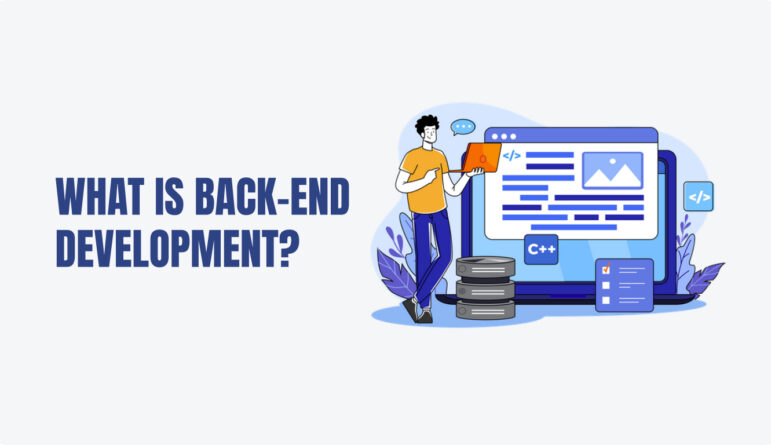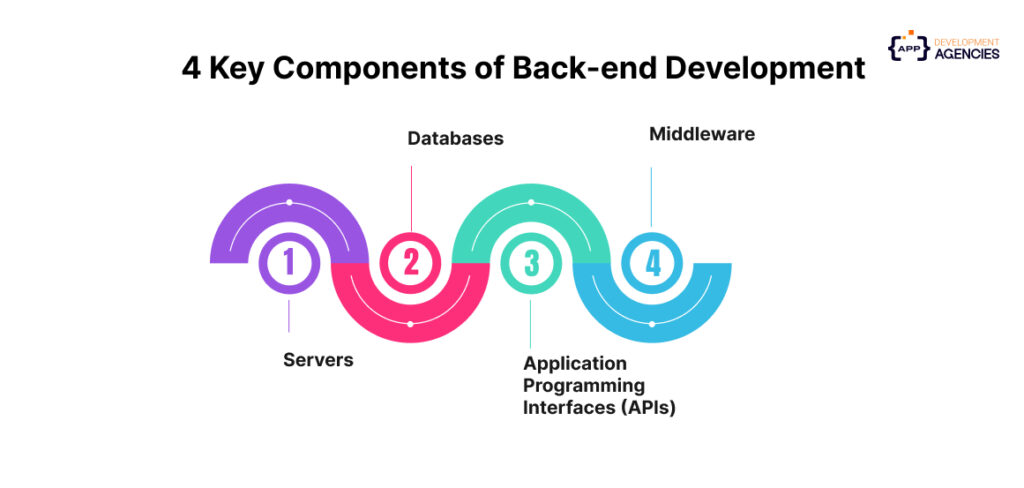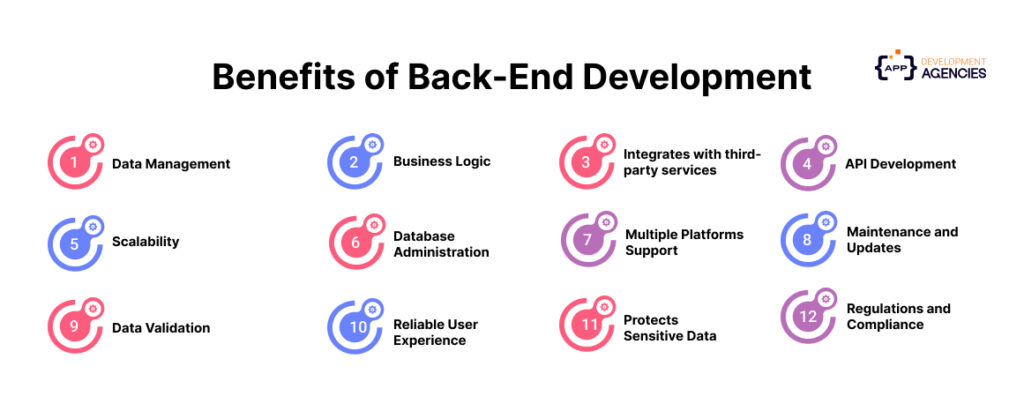
Nowadays, no one can survive without applications. Applications are used constantly for anything from ordering food to exchanging photos with loved ones to conducting financial transactions. These apps offer a smooth and simple user experience, but have you ever wondered how? All the credit goes to the application’s backend which does all the necessary tasks that you don’t see.
A frontend and a backend are common in applications. The user interface, or frontend, is where people interact. The back-end is in charge of the general functionality of an application and operates on a server in the background.
These commands are carried out on the back-end, and the results are pushed back to the frontend whenever you submit form data, upload files, access databases, or perform other intricate actions.
Therefore, back-end development may be thought of as the process of creating the application’s core. Back-end engineers use many frameworks, libraries, open-source programming languages, and APIs to complete their work during development.
We go over the fundamentals of back-end development in this informative guide, covering which programming languages and frameworks to employ.
So, let’s get started.
The inner workings of websites and apps are made possible by back-end development. It is the code that drives the application, database, and server—in other words, everything that occurs on the server side.
Building out the database, integrating APIs, and configuring the server-side technologies that make a website work are all tasks performed by back-end web developers. The website wouldn’t work without you. You might therefore be the ideal candidate for a client’s upcoming web project if you are an expert in server-side programming.
Now that you know what back-end development includes, examine the definition of a back-end developer.
After learning the basics of backend development, it’s critical to understand its role. Focusing on website architecture, scripting, and building code that connects the user’s browser to the website’s database are all part of a backend developer’s work. Data integrity and consistency must be guaranteed. Server-side web application logic and integrating front-end developers’ work are the responsibilities of a back-end developer.
Now, let’s understand the key components of back-end development.

Web developers typically utilize these four main elements in the background to create a web application’s backend.
Web servers are powerful computers or systems that handle resources, host apps, and process requests. They ensure the effective distribution of data and application functionality across the internet. They receive and react to requests from clients (such as web browsers or mobile apps).
Databases are essential for keeping and organizing data used by applications. They are a structured system for storing, managing, and retrieving data. Back-end developers build and optimize data storage solutions. It includes SQL Server, a well-known relational database management system created by Microsoft, using various database technologies (such as SQL and NoSQL). Backend developers create queries, construct database schemas, and guarantee safe and effective data retrieval.
APIs are a collection of guidelines, procedures, and instruments for software development and enabling communication between various software components. They facilitate front-end and back-end interaction, data exchange, and integration with web servers.
A software layer that connects, processes, and enables communication across different application components. It includes servers, relational databases, and APIs, all while working in the background. Request management, authentication, and data transformation are all backed by middleware.

The following points show the significance of back-end development:
Database management, retrieval, and storage are handled by the backend. This guarantees the systematic and effective management of substantial amounts of data.
The backend is in charge of carrying out an application’s business logic. To guarantee appropriate application functionality, it processes data, makes computations, and applies business rules.
Integration of several third-party services, including payment gateways, APIs, and external data sources, is the responsibility of back-end developers. These integrations can improve user experience and increase a website or application’s capabilities.
The backend is in charge of developing the Application Programming Interfaces (APIs). It enables communication between various system components. It guarantees a flawless user experience and facilitates integration with third-party services.
An application’s backend architecture is crucial to its scalability. Well-designed backend systems may readily grow to accommodate higher user traffic and loads.
Backend developers create databases, assuring effective data upkeep, retrieval, and storage. This is essential for apps that handle a lot of dynamic content.
Consistency and compatibility across different platforms and devices are guaranteed by backend logic. This protects the user experience while enabling users to access the application from many devices.
Backend development makes it simpler to maintain and upgrade apps. It modifies the application logic on the server without updating each client device separately.
Before data is entered into the database, it must be validated by the backend. By doing this, data integrity is guaranteed and inaccurate or inconsistent data is not stored.
Backend development creates a consistent user experience. It guarantees that all users receive the same data and functionality regardless of the platform or device.
The back-end is in charge of putting strong authorization and authentication procedures in place, preserving private information, and defending the application from potential attacks or weaknesses.
Backend developers integrate features and procedures to guarantee that applications adhere to industry standards and legal requirements, including data protection legislation.
Both front-end development and back-end development are necessary for the majority of websites. Front-end and back-end developers must constantly collaborate despite being two separate disciplines to guarantee the greatest result: a quick, highly interactive, aesthetically beautiful, and fully functional website.
The table below provides a summarized version of the differences between front-end and back-end development:
| Particulars | Front-End Development | Back-End Development |
| Main area of focus | User Interface (UI) and User Experience (UX) | Server-side logic, databases, and APIs |
| Key programming languages | HTML, CSS, JavaScript | Java, Python, Ruby, PHP, Node.js |
| Frameworks | React, Angular, Vue.js | Spring, Django, Laravel, Express.js |
| Key responsibilities | Designing and implementing the visual layout, interactivity, and user experience | Server configuration, database management, application logic, API development |
| Tools and technologies | Web browsers, CSS preprocessors, JavaScript libraries | Databases (SQL, MongoDB), servers, API tools, version control (Git) |
| Performance | Ensuring fast load times, responsive design, and smooth user interactions | Optimizing server response time, database query efficiency, and API performance |
| Security concerns | Protecting against XSS, CSRF, ensuring secure user interactions | Implementing authentication, encryption, and data protection measures |

Writing code outlining the program’s essential features is the first step in back-end development. After that, you’ll handle APIs, administer database activities, and host the code on a server. Let’s discuss each of these domains.
The hardware that processes requests, stores and retrieves data, and provides the required information over a network is called a server. They have storage devices and RAM for storing files and performing other calculations.
A website is given a unique URL and IP address when it is deployed on a server. Then, users can use that URL to visit your application. Even better, you may utilize an API to help your front-end web pages and back-end applications communicate with one another by hosting them on different servers.
On-premises or cloud hosting are your two options. Although cloud hosting is excellent for quick scalability, improved availability, and uptime, it can become costly if your website uses a lot of resources.
Conversely, you have complete control over the IT infrastructure with on-premise hosting. The drawback is that resource constraints might make scaling to handle more online traffic challenging.
Since databases store a wide range of data, including user and employee information, product details, multimedia files, and more, they are an essential component of back-end development.
Using SQL or NoSQL databases will depend on your project. SQL relational databases are perfect for structured data since they store information in tables and rows. For example, Oracle Database and PostgreSQL. They also follow ACID principles, improving data integrity, safety, and dependability.
However, unstructured or semi-structured data is the main use case for NoSQL databases like MongoDB and Firebase. They can therefore adjust to shifting data requirements.
You can use databases to carry out tasks including retrieving records, altering or updating data that already exists, and removing particular records.
Application programming interfaces, or APIs, provide communication between the front and back-ends. For instance, information entered by users on the frontend is transmitted to the backend over an API for processing or storing. Requested information can also be sent from the backend to the frontend for user presentation. This is how Netflix retrieves a list of films and TV series to display on the user interface from its back-end database.
An API that is CRUD (Create, Read, Update, and Delete) is usually necessary for software applications. This indicates that users can alter particular entries, remove some or all records, retrieve existing data in JSON or other supported formats, and create new records on the databases via the API.
The middleware sits at the heart of the frontend and underlying APIs. Middleware (server-side software) enables client-server connection by creating an intermediate layer between the application or applications and the network, server, database, operating system, and other components. Whether it’s the presentation layer or the business layer, middleware can be arranged into various site levels.
Effective middleware may boost IT productivity and support several functions. It includes authentication, content management, business process management, and user engagement. An illustration of a server-side JavaScript framework is Koa.js.

Programming languages and frameworks are collections of instructions that programmers write to tell the computer how to do something, particularly when creating software. Back-end developers deal with a variety of programming languages & frameworks, primarily:
Programmers utilize programming languages, which are computer languages, to interact with computers and produce software. These languages include:
Frameworks are designed to make building and deploying web applications much easier. They provide a standard way to build applications while providing different libraries, templates, data-access solutions, authentication and authorization solutions, security measures and boilerplate code, among many other features. Some of the most popular frameworks include:
The foundation of web applications is back-end development. It guarantees reliable functionality, smooth communication, and effective data administration. It takes knowledge of various tools and technologies to ensure that everything functions as a whole. Back-end development will continue to play a critical role in creating dependable, effective, and secure digital experiences as web applications become more complicated.
The goal of this blog post was to provide you with a thorough grasp of backend development. Now that you have this understanding, you can see how important backend development is to building effective and useful websites and applications.
We hope this informative post has helped you on your backend journey. Please feel free to ask questions in the comments section below. We’ll respond to you as soon as possible!